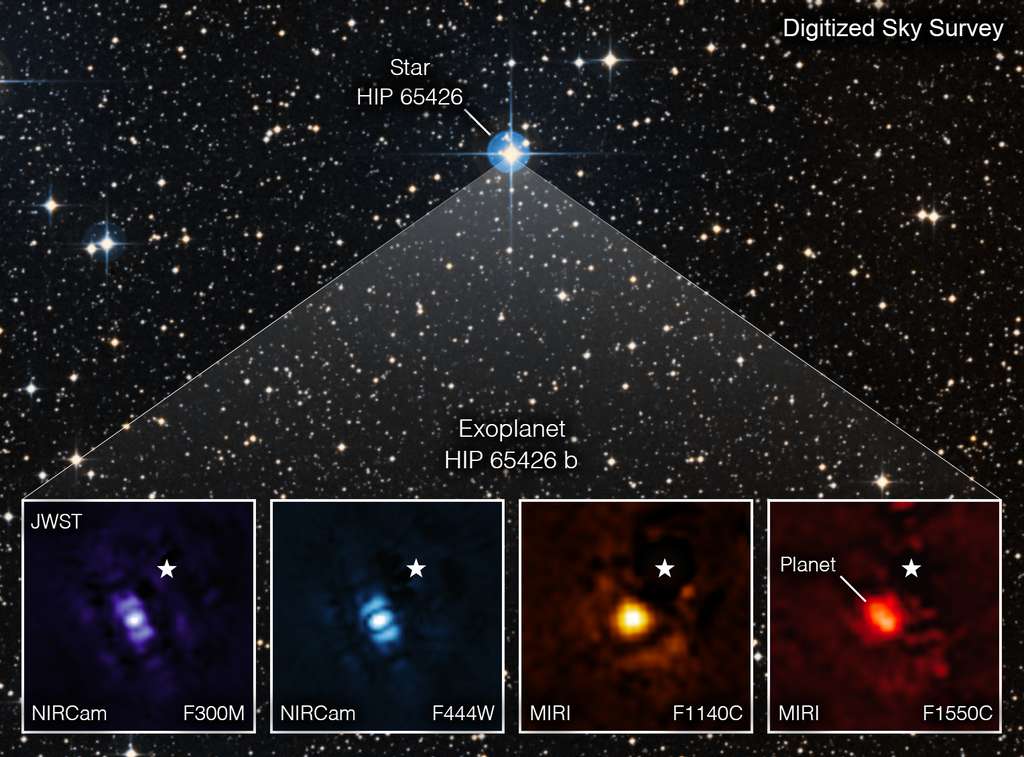Launched on December 25, 2021, the James Webb completed its test phase in July 2022. The science programs have since begun and are already producing their first results, including the first mid-infrared image of an exoplanet, named HIP 65426 b.
| Characteristics of the exoplanet HIP 65426 b It is a very young giant exoplanet, about 15 million years old, located at 90 astronomical units from its star. With a mass estimated at about 7 times that of Jupiter, it had been discovered with the European instrument SPHERE [1] at the Very Large Telescope in 2017 [2]. |
The instruments of the James Webb now make possible the direct observation of the exoplanet in the infrared.
It is thanks to the NIRCAM and MIRI instruments that HIP 65426 has just been observed [Carter et al. 2022 https://arxiv.org/pdf/2208.14990.pdf ]] within the framework of a program "Early Release Science" carried out by an international collaboration including several French researchers resulting from the laboratories of IPAG, LAM, LESIA of the Observatoire de Paris - PSL, CEA and the Laboratoire Lagrange

MIRI is the only mid-infrared instrument of the James Webb. Its imaging system has been designed in part by a consortium of French laboratories led by CEA/AIM.
It embeds a coronagraphic system thanks to which the light coming from the central star is strongly attenuated, which makes it possible to obtain images of exoplanets and to study their atmosphere.
Instrumental performances beyond all expectations
The MIRI coronographs are based on a technological innovation [3] invented at the Observatoire de Paris - PSL. According to Anthony Boccaletti, CNRS research director at LESIA within the Observatoire de Paris - PSL, "the coronographs reach better performances than those initially expected".
The publication [4] of these results published in July 2022 shows that starlight can be attenuated by a factor of 10 000 to 100 000.
"These coronagraphs operate at wavelengths of 10.65, 11.40 and 15.50 microns, specially chosen to probe the atmosphere of giant exoplanets, to identify molecules such as ammonia, and to complement the observations obtained on the ground in near infrared", explains Pierre Baudoz, astronomer at Paris Observatory - PSL.

The data collected on HIP 65426 b provide the first robust measurement of the temperature in the atmosphere of this exoplanet: 1400°C. This corresponds to the temperature of the flame of a lighter. It is thus expected that small grains of silicate dust will form and remain suspended in the atmosphere of the object.
JWST thus demonstrates its potential to study in detail the physico-chemical properties of these extrasolar worlds and better understand their formation. The images could also reveal new planets still unknown in these systems.
These spectacular images are the first of an entire program dedicated to direct observations of nearby planetary systems.
Researchers will study a younger system of 5 million years, around which there is still a lot of gas and dust to determine, for example, if these dusts contain water ice like comets in our Solar System.
| In video |
Reference
This result is published in the journal Astronomy & Astrophysics intitulée "The JWST Early Release Science Program for Direct Observations of Exoplanetary Systems I: High Contrast Imaging of the Exoplanet HIP 65426 b from 2−16 μm", Carter et al. 2022
___________________________________________________________
[1] SPHERE is an instrument designed by a European consortium led by a French laboratory.
[2] Chauvin et al. 2017 https://arxiv.org/pdf/1707.01413.pdf and press release ESO https://www.eso.org/public/images/ann17041a/
[3] animated film on the operation of MIRI for the observation of exoplanets https://youtu.be/xMT3LxNphzI
[4] Boccaletti et al. 2022 https://arxiv.org/pdf/2207.11080.pdf and press release ESO https://www.eso.org/public/images/ann17041a/
